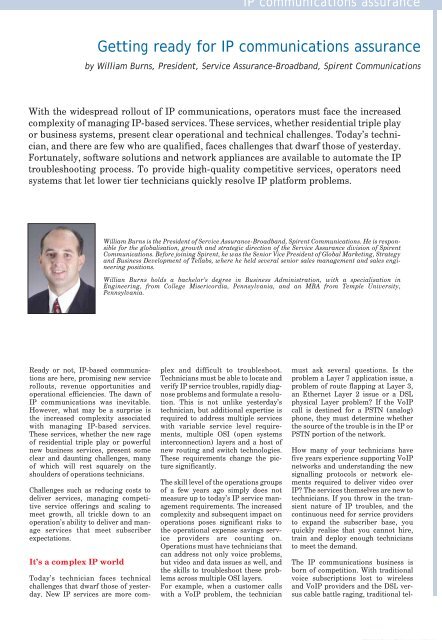Authors include: - Connect-World
Authors include: - Connect-World
Authors include: - Connect-World
Create successful ePaper yourself
Turn your PDF publications into a flip-book with our unique Google optimized e-Paper software.
IP communications assurance<br />
Getting ready for IP communications assurance<br />
by William Burns, President, Service Assurance-Broadband, Spirent Communications<br />
WiththewidespreadrolloutofIPcommunications,operatorsmustfacetheincreased<br />
complexityofmanagingIP-basedservices.Theseservices,whetherresidentialtripleplay<br />
orbusinesssystems,presentclearoperationalandtechnicalchallenges.Today’stechnician,andtherearefewwhoarequalified,faceschallengesthatdwarfthoseofyesterday.<br />
Fortunately,softwaresolutionsandnetworkappliancesareavailabletoautomatetheIP<br />
troubleshooting process. To provide high-quality competitive services, operators need<br />
systemsthatletlowertiertechniciansquicklyresolveIPplatformproblems.<br />
The IP communications business is<br />
bornofcompetition.Withtraditional<br />
voice subscriptions lost to wireless<br />
andVoIPprovidersandtheDSLver-<br />
suscablebattleraging,traditionaltel-<br />
WilliamBurnsisthePresidentofServiceAssurance-Broadband,SpirentCommunications.Heisresponsiblefortheglobalisation,growthandstrategicdirectionoftheServiceAssurancedivisionofSpirent<br />
Communications.BeforejoiningSpirent,hewastheSeniorVicePresidentofGlobalMarketing,Strategy<br />
andBusinessDevelopmentofTellabs,whereheheldseveralseniorsalesmanagementandsalesengineeringpositions.<br />
Willian Burns holds a bachelor’s degree in Business Administration, with a specialisation in<br />
Engineering, from College Misericordia, Pennsylvania, and an MBA from Temple University,<br />
Pennsylvania.<br />
Ready or not, IP-based communicationsarehere,promisingnewservice<br />
rollouts, revenue opportunities and<br />
operational efficiencies. The dawn of<br />
IP communications was inevitable.<br />
However, what may be a surprise is<br />
the increased complexity associated<br />
with managing IP-based services.<br />
Theseservices,whetherthenewrage<br />
of residential triple play or powerful<br />
new business services, present some<br />
clear and daunting challenges, many<br />
of which will rest squarely on the<br />
shouldersofoperationstechnicians.<br />
Challenges such as reducing costs to<br />
deliver services, managing competitive<br />
service offerings and scaling to<br />
meet growth, all trickle down to an<br />
operation’sabilitytodeliverandmanage<br />
services that meet subscriber<br />
expectations.<br />
It’sacomplexIPworld<br />
Today’s technician faces technical<br />
challengesthatdwarfthoseofyesterday.<br />
New IP services are more complex<br />
and difficult to troubleshoot.<br />
Techniciansmustbeabletolocateand<br />
verifyIPservicetroubles,rapidlydiagnoseproblemsandformulatearesolution.<br />
This is not unlike yesterday’s<br />
technician,butadditionalexpertiseis<br />
required to address multiple services<br />
with variable service level requirements,<br />
multiple OSI (open systems<br />
interconnection) layers and a host of<br />
new routing and switch technologies.<br />
These requirements change the picturesignificantly.<br />
Theskillleveloftheoperationsgroups<br />
of a few years ago simply does not<br />
measureuptotoday’sIPservicemanagementrequirements.Theincreased<br />
complexityandsubsequentimpacton<br />
operations poses significant risks to<br />
theoperationalexpensesavingsservice<br />
providers are counting on.<br />
Operationsmusthavetechniciansthat<br />
can address not only voice problems,<br />
butvideoanddataissuesaswell,and<br />
the skills to troubleshoot these problemsacrossmultipleOSIlayers.<br />
For example, when a customer calls<br />
with a VoIP problem, the technician<br />
must ask several questions. Is the<br />
problemaLayer7applicationissue,a<br />
problemofrouteflappingatLayer3,<br />
an Ethernet Layer 2 issue or a DSL<br />
physical Layer problem If the VoIP<br />
call is destined for a PSTN (analog)<br />
phone, they must determine whether<br />
thesourceofthetroubleisintheIPor<br />
PSTNportionofthenetwork.<br />
How many of your technicians have<br />
fiveyearsexperiencesupportingVoIP<br />
networksandunderstandingthenew<br />
signalling protocols or network elements<br />
required to deliver video over<br />
IPTheservicesthemselvesarenewto<br />
technicians.Ifyouthrowinthetransient<br />
nature of IP troubles, and the<br />
continuousneedforserviceproviders<br />
to expand the subscriber base, you<br />
quickly realise that you cannot hire,<br />
train and deploy enough technicians<br />
tomeetthedemand.<br />
19

















